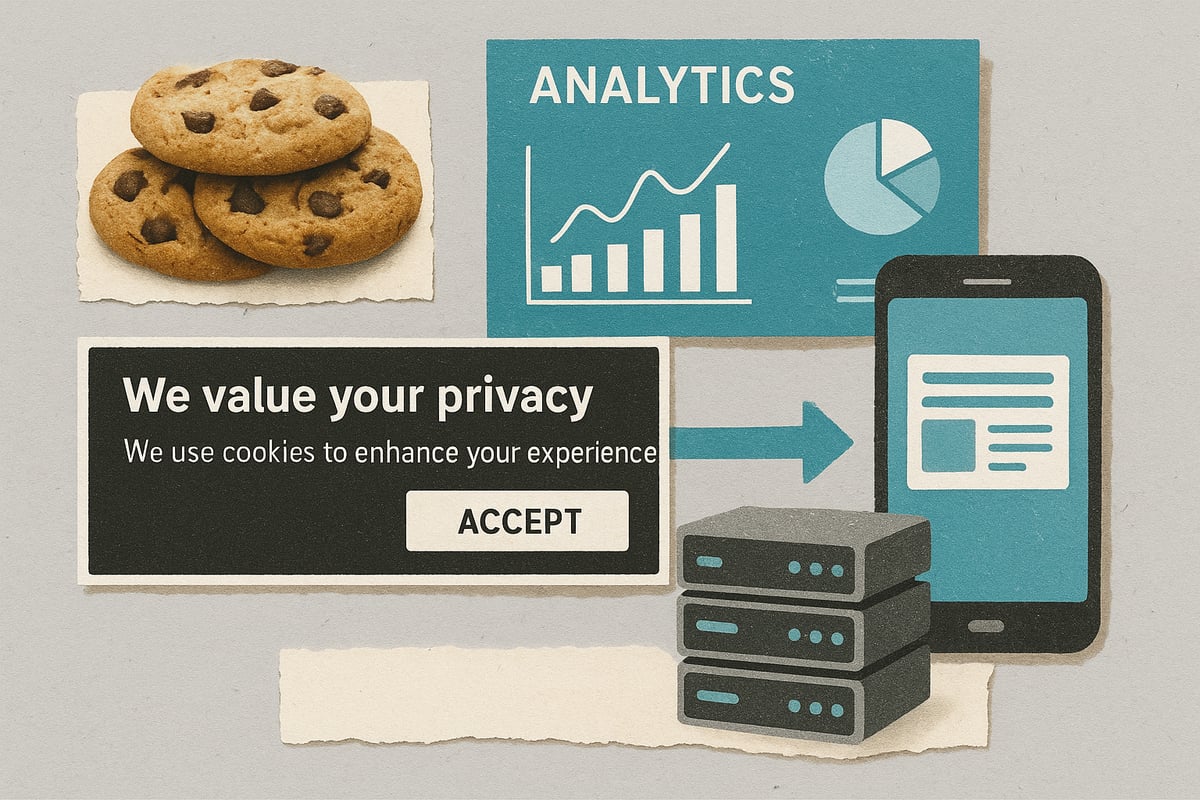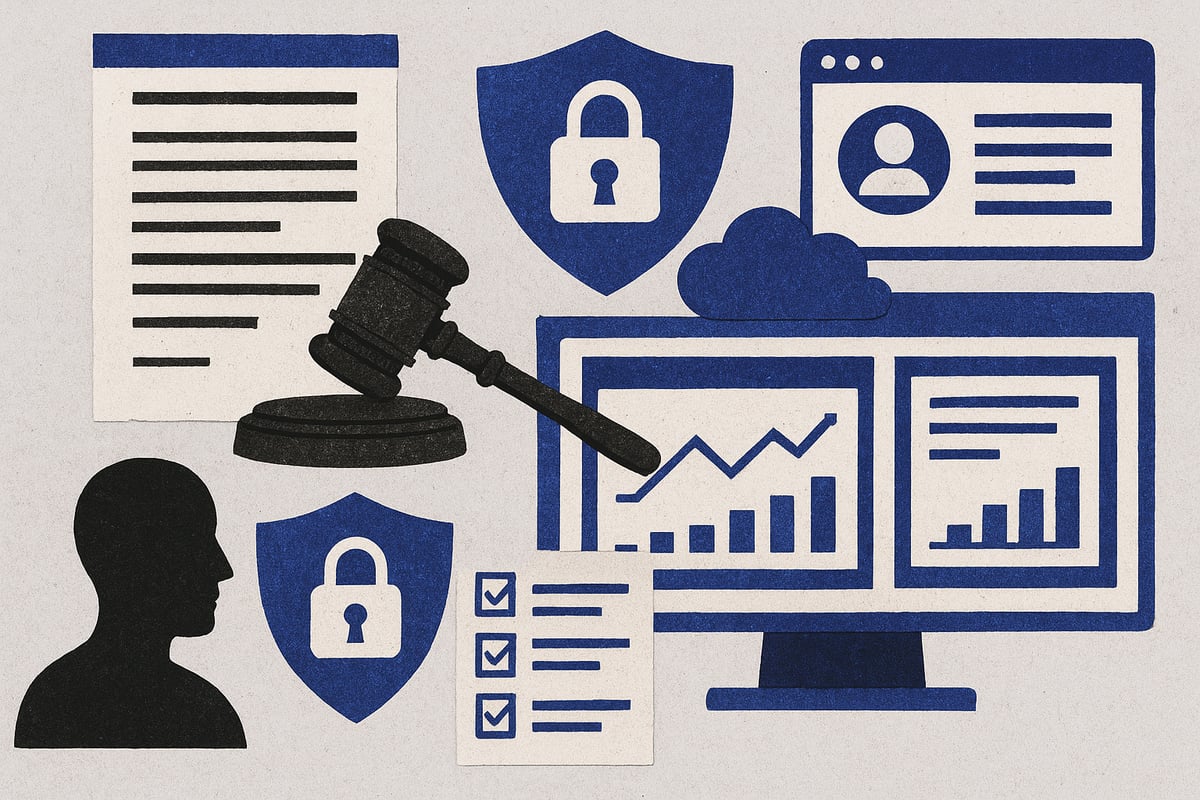- Date
The Essential Guide to Website Data in 2025
 Andrii Romasiun
Andrii Romasiun
In 2025, website data is at the center of digital growth and risk. From small blogs to enterprise platforms, understanding website data is essential for anyone looking to thrive in the online world.
This guide will break down what website data means today. We will explore how collection techniques are evolving, the impact of privacy laws, and the latest analytics tools. You will learn actionable steps to manage website data effectively while respecting user privacy.
Ready to unlock the power of website data? Let’s dive in and turn complex concepts into clear, practical strategies.
What is Website Data? Definitions and Core Components
Website data is the digital information generated, stored, and exchanged when users interact with a site. This data forms the foundation of every online experience, powering everything from personalization to analytics. Understanding the different components of website data helps organizations make informed decisions about privacy, performance, and user engagement.

Types of Website Data
Website data comes in several forms, each serving distinct functions. The most common types include cookies, cache, and local storage. Cookies store small bits of information, such as login sessions or user preferences. Cache speeds up load times by saving resources locally. Local storage allows sites to save larger data sets for features like offline editing.
User behavior data captures actions like clicks, page views, and session durations, revealing how visitors interact with a website. Technical data, such as device and browser information, is collected to optimize compatibility and troubleshoot issues. Third-party data arises from analytics scripts, ads, or embedded content. For example, Facebook cookies and Google Analytics tags both generate website data even if you never log in.
To learn more about cookies as a key type of website data, see Everything You Need to Know About Cookies. Even a single visit can generate multiple data types, highlighting the complexity behind every online interaction.
How Website Data is Generated and Stored
Website data is produced through both user actions and automated scripts. Clicking a link, filling out a form, or simply loading a page can trigger data collection. Some data is handled client-side, stored in the browser, while other data is sent to the server. Temporary (session) data is cleared when the browser closes, while persistent data remains until deleted.
For instance, local storage enables features like offline editing in cloud-based apps such as Google Docs. Cookies are used for authentication and keeping users logged in. The volume of website data stored varies widely, depending on site complexity and features. Some sites store minimal data, while others, like collaborative platforms, utilize extensive data storage to support rich user experiences.
The Role of Website Data in User Experience
Website data plays a crucial role in shaping user experience. It enables personalization by remembering preferences, such as language settings or saved progress in a course. Cached resources result in faster load times, making navigation smoother for repeat visitors. Authentication relies on website data to maintain session continuity, so users remain logged in as they move between pages.
Common examples include shopping carts that remember selected items, or sites that recall your theme preference. However, collecting too much website data can raise privacy concerns. Organizations must balance the benefits of enhanced usability with the risks of overcollection and potential user mistrust.
Common Misconceptions About Website Data
Many believe the amount of website data stored is directly tied to the time spent on a site, but this is not always the case. Some sites generate significant data from a single interaction, while others store little despite lengthy sessions. Users may notice “unknown” domains in their browser’s data list, often stemming from third-party integrations like analytics or embedded widgets.
Not all website data is personally identifiable. Technical logs and anonymized analytics do not always reveal user identities. When users delete website data, they may lose logins and custom settings but other information, like site visit logs, might remain unaffected. Understanding these nuances helps users make informed choices about their digital footprint.
Website Data on Mobile Devices: Special Considerations
Mobile devices handle website data differently from desktops. Both iOS and Android offer built-in tools to manage stored website data, with varying levels of transparency. Safari’s Website Data list, for example, displays a range of domains, including those used by embedded content or third-party services.
Cross-device syncing and cloud storage add another layer of complexity. Data saved on one device may be accessible on another through browser sync features. A common scenario is Facebook cookies appearing on non-Facebook sites, due to embedded widgets or login integrations. These unique aspects make managing website data on mobile devices especially important for privacy-conscious users.
Website Data Collection Methods in 2025
The landscape of website data collection has transformed rapidly in recent years. With new regulations and technology shifts, site owners must adopt smarter, privacy-conscious methods. Understanding the latest strategies is crucial for anyone responsible for website data.

Evolution of Data Collection Technologies
Website data collection has evolved far beyond basic cookies. Today, advanced tracking scripts and real-time analytics are common. Session replay tools allow site owners to watch user interactions as they happen, providing deep behavioral insights.
The shift toward cookie-less tracking is gaining speed. Technologies like browser fingerprinting and server-side identifiers can uniquely recognize users without storing cookies. Machine learning now powers behavioral analytics, uncovering trends from massive datasets. If you want a comprehensive overview of these advancements, check the Guide to Tracking Website Data.
Even a single visit can generate multiple types of website data using these modern tools.
First-Party vs. Third-Party Data Collection
First-party data is collected directly by the site you visit. This includes actions like clicks, form fills, and login sessions. Third-party data, however, comes from embedded scripts or widgets, such as advertising networks or social media integrations.
A growing trend is the move away from third-party solutions due to increased browser privacy protections. Browsers now block many third-party cookies by default, making first-party data strategies more reliable for website data collection.
| Type | Collected By | Example |
|---|---|---|
| First-party | Site owner/server | User logins |
| Third-party | External services | Ad trackers |
Understanding the distinction helps ensure compliance and accuracy in website data.
Privacy-First and Cookie-less Analytics Solutions
Privacy regulations are pushing organizations to adopt analytics that do not depend on cookies. Cookie-less solutions use methods like IP masking or aggregate data, eliminating the need for intrusive pop-ups.
Platforms such as Swetrix, Plausible, and Matomo lead in this area, offering privacy-focused analytics for website data. These tools anonymize user information and often skip storing any identifiers at all.
Benefits include higher user trust and sometimes even better data accuracy, since fewer users opt out. This shift aligns with the rising demand for ethical website data practices.
Server-Side and Edge Data Collection
Moving data collection from the browser to the server or edge delivers several advantages. Server-side analytics capture website data directly from the server logs, increasing accuracy and reducing the risk of ad blockers interfering.
Edge data collection, which processes data closer to the user, enables real-time personalization and faster insights. However, these methods can be technically challenging to implement and might offer less granularity for client-side events.
For example, edge analytics can instantly adapt content for different regions, improving user experience while safeguarding website data.
Consent Management and User Control
With GDPR, CCPA, and similar laws, websites must obtain clear consent before collecting personal data. Modern consent banners and user preference centers give users more control over website data.
These tools affect the volume and accuracy of collected data. Opt-in rates, for instance, determine how much user behavior you can analyze. Keeping transparent records and updating consent mechanisms regularly is now essential.
This focus on user control is reshaping website data strategies and encouraging more ethical practices.
Data Minimization and Ethical Data Collection
Responsible website data collection means gathering only what you truly need. Data minimization reduces risk and builds user trust. Regular audits help identify unnecessary data points, keeping your footprint lean.
Transparency is key. Clear privacy policies and easy-to-use data request tools empower users to manage their website data. Ethical data collection not only ensures compliance but also strengthens your brand’s reputation.
By embracing these principles, organizations can balance valuable insights with respect for user privacy.
Regulatory Landscape: Privacy, Compliance, and Data Ownership in 2025
In 2025, the regulatory environment for website data is more dynamic than ever. New laws, evolving compliance standards, and user expectations are reshaping how organizations collect, store, and leverage website data. Staying ahead means understanding the latest rules, adopting best practices, and embracing technologies designed to protect both business interests and user rights.

Major Data Privacy Laws and Updates
Global regulations governing website data are expanding rapidly. The General Data Protection Regulation (GDPR) continues to set the standard for user rights and data handling in Europe, while the California Consumer Privacy Act (CCPA) leads in the U.S. In 2025, new laws address AI-driven data processing and biometric identifiers, requiring businesses to adapt quickly. Enforcement is stricter, with significant penalties for noncompliance making headlines. For a comprehensive overview of the upcoming legal landscape, see the Data Privacy Laws in 2025 guide. Staying informed about these changes is essential for anyone responsible for website data.
Impact of Regulations on Website Data Practices
Regulatory updates have a direct impact on how organizations handle website data. Consent banners and user preference centers are now standard, ensuring transparency and choice. Data retention periods are strictly enforced, and anonymization techniques are widely adopted to protect user identities. Technical adaptations, such as pseudonymization, reduce risk while maintaining analytical value. These measures affect everything from marketing analytics to customer support, making compliance an integral part of daily operations. Understanding the influence of laws on website data is crucial for building trust and achieving long-term success.
Data Ownership and User Rights
A central question in 2025 is, who truly owns website data? Users are increasingly empowered, with rights to access, correct, and delete their personal information. Site owners must honor data portability requests, enabling users to export their website data easily. Efficient processes for deletion requests are essential to comply with regulations and avoid penalties. By establishing clear ownership boundaries and respecting user rights, organizations can foster loyalty and reduce legal exposure. Transparent practices around website data ownership benefit both users and businesses.
Privacy-Enhancing Technologies and Tools
To meet regulatory demands, organizations are investing in privacy-enhancing technologies for website data. Encryption, data masking, and secure storage protocols are standard components. Privacy by Design principles guide development, ensuring that data protection is embedded from the start. Automated compliance platforms help conduct regular privacy audits, flagging risks before they become issues. These tools not only safeguard website data but also streamline compliance, making it easier to keep up with evolving laws. The right technologies are invaluable for protecting both users and organizations.
The Role of Privacy-Focused Analytics Platforms
Privacy-focused analytics platforms are gaining traction as organizations seek to balance insights with compliance. By avoiding cookies and supporting GDPR requirements, these tools protect website data and build user trust. Platforms like Swetrix offer real-time analytics, error tracking, and customizable alerts, all while ensuring data ownership remains with the site owner. Open-source and self-hosted options provide additional control for privacy-conscious teams. As regulations tighten, adopting privacy-first analytics becomes a strategic advantage for any business relying on website data to drive growth.
Leveraging Website Data for Growth and Optimization
Website data is the engine that drives digital growth and informed decision-making. When harnessed effectively, it reveals not just what happens on your site, but why users behave as they do. Let us explore how to translate raw website data into actionable strategies for optimization and sustainable business success.

Actionable Insights from Website Data
To unlock growth, organizations must turn website data into actionable insights. This process starts by identifying which pages and features attract the most engagement. By analyzing user journeys, you can pinpoint which content keeps visitors engaged and where they drop off.
Conversion funnel analysis helps reveal friction points, while heatmaps and session replays provide visual evidence of user interactions. For instance, optimizing landing pages based on this intelligence can directly boost conversions. For a deeper dive into how to leverage website data for performance and growth, see the Ultimate Guide for Website Optimisation.
Personalization and Dynamic Content
Modern users expect experiences tailored to their preferences. Website data enables real-time personalization, such as displaying recommended products or content based on past behavior. A/B testing allows you to compare different versions of a page, using data to determine which design resonates best.
Adaptive interfaces can adjust based on device type, location, or even time of day. However, it is essential to balance personalization with transparency, ensuring users understand how their website data shapes their experience. Ethical data use builds trust and long-term loyalty.
Performance Monitoring and Error Tracking
The speed and reliability of your site influence both user satisfaction and search rankings. Website data can be used to monitor performance metrics like load times, uptime, and error rates. Real-user monitoring captures actual visitor experiences, while synthetic tests simulate traffic to detect potential issues.
Tracking technical errors and slowdowns enables you to address problems before they impact users. For example, reducing load times directly decreases bounce rates and increases session duration, highlighting the tangible value of website data for optimization.
Marketing Attribution and Campaign Tracking
Understanding the effectiveness of your marketing efforts requires comprehensive analysis of website data. Attribution models help identify which channels drive conversions, whether it is organic search, social media, or paid campaigns.
Tracking with UTM parameters and multi-touch attribution gives a clear view of the customer journey. This allows you to allocate resources to the most effective channels. By continuously analyzing campaign performance, you ensure that every marketing dollar is optimized, making website data essential for ROI measurement.
Data Visualization and Reporting
Raw website data is only valuable when it can be interpreted and shared. Dashboards transform complex metrics into clear, actionable visuals for stakeholders at all levels. Custom reports can be tailored to highlight trends, anomalies, or KPIs relevant to different teams.
Automated alerts signal when something unusual occurs, such as a sudden drop in traffic. Visualizing user flows and behaviors helps inform redesigns and strategic decisions, ensuring that website data supports ongoing improvement.
Balancing Data Utility and User Privacy
Maximizing the benefits of website data requires a careful approach to privacy. Data minimization—collecting only what is necessary—reduces risk and fosters user trust. Privacy-centric segmentation and anonymized analytics allow for meaningful insights without compromising individual identities.
Communicating transparently with users about data collection practices is key. For more on privacy-first analytics solutions, explore Privacy-Friendly Analytics Explained. Ethical website data management is not just a regulatory requirement, but a competitive advantage in 2025.
Best Practices for Managing Website Data in 2025
Effectively managing website data in 2025 requires a proactive, structured approach. Organizations must balance innovation, compliance, and user trust. By following these best practices, you can safeguard data, optimize operations, and stay ahead of regulatory changes.
Data Governance and Documentation
Establishing robust governance is the foundation of responsible website data management. Assign clear roles for data ownership, stewardship, and access. Maintain a detailed inventory of all data types collected, processed, and stored. Document processing activities to support audits and compliance reviews.
Regular record-keeping is essential for transparency. Implement frameworks that align with evolving privacy regulations. For a deeper dive into critical privacy focus areas, review the 10 Areas for Privacy Programs in 2025. These insights can help you anticipate regulatory shifts and strengthen your website data practices.
Data Security and Risk Management
Securing website data at every stage is non-negotiable. Use encryption for both data in transit and at rest, protecting sensitive information from interception or unauthorized access. Limit permissions based on necessity, and regularly update security protocols.
Develop a comprehensive incident response plan. This should outline steps for breach detection, containment, notification, and remediation. Conduct periodic vulnerability assessments and penetration testing to proactively identify risks. Monitoring security trends is vital as threats to website data continue to evolve.
Data Retention and Deletion Strategies
Setting clear retention policies ensures website data is only stored as long as necessary. Classify data by type and assign appropriate retention periods. Automate deletion workflows to regularly purge outdated or unnecessary data.
Respond promptly to user deletion requests in line with regulations. For example, complying with right to be forgotten laws requires efficient processes for identifying and erasing personal data. Well-defined strategies protect user privacy and reduce unnecessary storage costs associated with website data.
User Education and Transparency
Transparency is key to building trust around website data. Clearly explain what data is collected, why, and how it is used. Make privacy policies accessible and understandable. Offer interactive dashboards or preference centers where users can view and manage their data choices.
Educate users about the benefits and risks of data collection. Regularly update them on changes to policies or practices. By fostering open communication, you empower users to make informed decisions about their website data.
Choosing the Right Analytics Tools
Selecting analytics platforms that align with your website data goals is crucial. Evaluate tools based on privacy compliance, accuracy, scalability, and integration capabilities. Consider whether open-source or proprietary solutions best fit your organization’s needs.
Compare features such as real-time reporting, customizable dashboards, and privacy-centric design. Choose platforms that offer granular controls for data collection and retention. The right tools will help you extract actionable insights from website data without compromising user privacy.
Preparing for Future Trends in Website Data
Staying ahead means anticipating how website data practices will change. Watch for advances in AI-driven analytics, predictive modeling, and zero-party data collection. Keep an eye on new browser restrictions and privacy controls that may impact tracking and personalization.
Regularly review emerging regulations and adapt your processes accordingly. For more on upcoming privacy laws and compliance strategies, explore Preparing for 2025: New U.S. Data Privacy Laws. Proactive adaptation ensures your website data management remains compliant, effective, and user-centric.
As we’ve explored, understanding website data in 2025 is all about balancing actionable insights with user privacy—especially as regulations and technology continue to evolve. If you’re looking for a straightforward way to gain deep visibility into your site’s performance while respecting your visitors’ privacy, you don’t have to compromise. Swetrix gives you detailed analytics, error tracking, and customizable alerts—all without cookies or intrusive banners. Plus, you maintain full control and ownership of your data. If you want a modern, ethical solution that’s easy to use and fully compliant, Try Swetrix today.